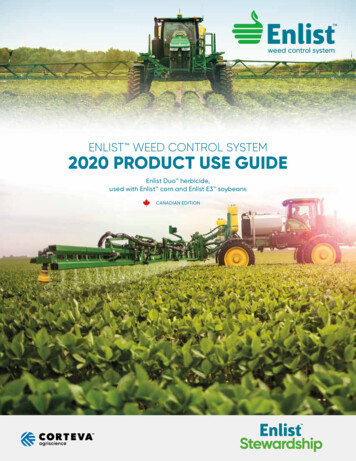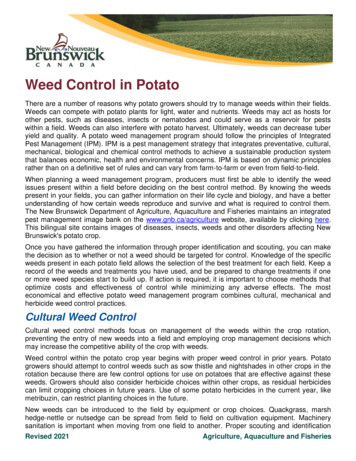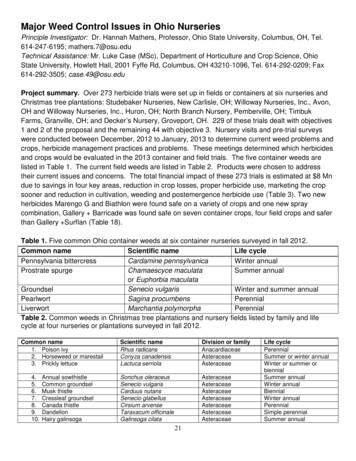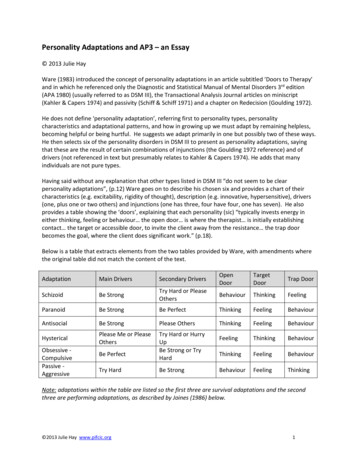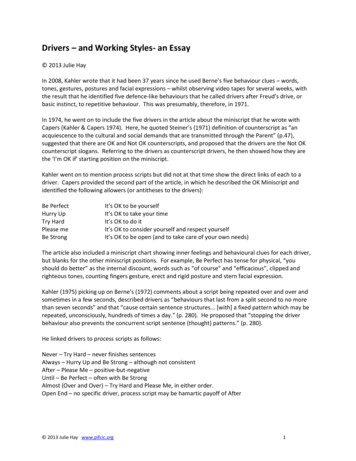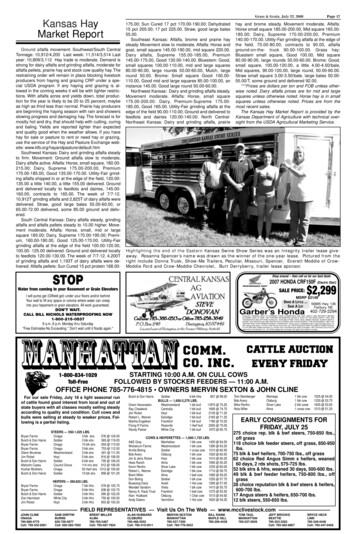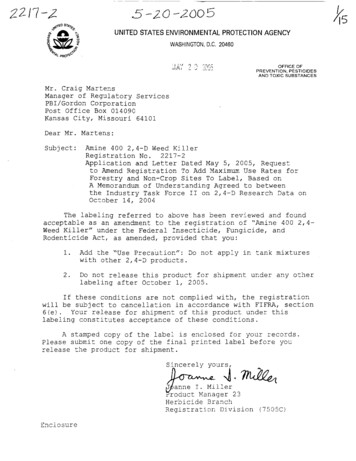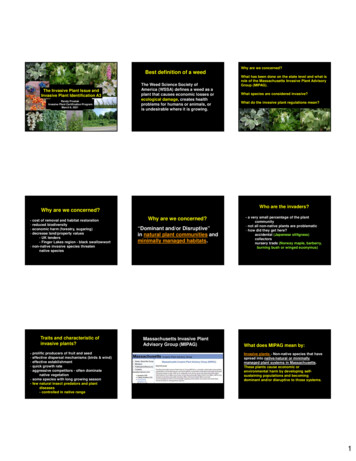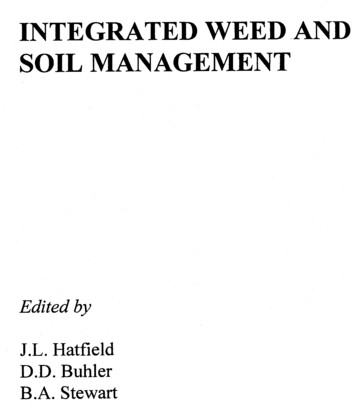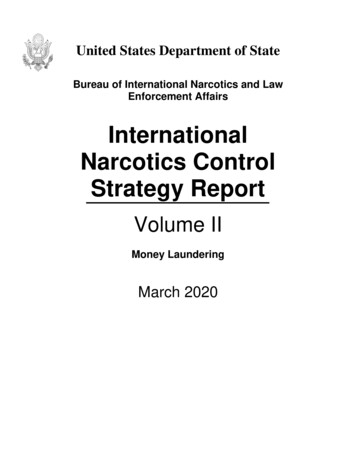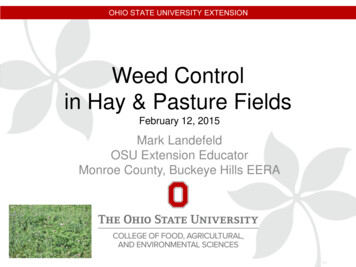
Transcription
Weed Controlin Hay & Pasture FieldsFebruary 12, 2015Mark LandefeldOSU Extension EducatorMonroe County, Buckeye Hills EERA
Why Control Weeds in Hay & Pastures? May limit new stand establishmentForage quality can be reducedWeeds can reduce yieldShade out beneficial plantsCan be poisonousAesthetics
Weed Life Cycles Summer annuals Plants that germinate from seed in thespring, flower and produce seed in mid tolate summer, and die in the fall. ControlApril – mid July-Examples include large crabgrass,barnyardgrass, common cocklebur, spinyamaranth, spurge, and ragweed.
Weed Life Cycles Winter annuals Plants that germinate from seed mostly inlate summer through winter, flower andproduce seed in late winter to spring, anddie in late spring to early summer. ControlNovember - March-Examples include annual ryegrass, hairybuttercup, chickweed, henbit, purpledeadnettle and cressleaf groundsel.
Weed Life Cycles Biennials Plants that complete their life cycle over twogrowing seasons. They germinate andproduce a vegetative rosette the first year.The second year, the plants bolt, flower,produce seed and die. Best controlled inrosette stage-Examples include musk thistle, bull thistle,wild carrot, common burdock and yellow rocket.
Weed Life Cycles Perennials Plants that produce a vegetative structure(taproot, tuber, bulb, rhizome, etc.), whichallows them to live for more than two years.Most perennials also reproduce from seed.Control is growth stage dependent-Examples include johnsongrass, buckhornplantain, horsenettle, tall ironweed, goldenrodand brambles.
Weed Control in Pastures Difficult challenge Weeds often grow on rough terrain/hillsides Livestock tracking opens the soil allowingweeds to germinate Herbicides kill the weeds, but may kill yourlegumes too
Options Available Fertility/FertilizationMultispecies grazingMowing/clippingHerbicides– Always check the label, there may begrazing/hay cutting restrictions etc.Combine all the above for an integratedapproach to weed management
Weed Management Starts With Fertility Pastures need managed so forage plantscan compete with weeds! Soil Test Adjust pH Adjust Phosphorus (P) & Potassium (K) Provide nitrogen– Legumes or commercial fertilizer applications Proper grazing management
Effects of pH onnutrient availabilityto plants
Purple DeadnettleA winter annual.Mature plants have square stemsand gently lobed triangular shapeleaves.Flowers are crowded at the end ofthe branches and form under theleaves. HenbitA winter annual.Mature plants have square stemswith whorled leaves and showy pinkto purple flowers.Flowers are above the upper leafwhorls.
Purple Deadnettle ControlAlfalfa Hay–––––EptamMetribuzinSinbarGlyphosate (spot treat)Paraquat Henbit ControlAlfalfa Hay–––––EptamMetribuzinSinbarGlyphosate (spot treat)Paraquat
Ground IvyA low growing, creeping perennial.Can reproduce by seeds, but mostoften reproduction is by stems thatroot at the nodes.Square stem plant with oppositeleaves that are rounded or heartshaped. Common MallowOften confused with Ground Ivy.Can grow as a winter annual, summerannual or biennial plant.Will grow erect, but is more oftenprostrate in its growth habit.Round stem with alternate leaf pattern.
Ground Ivy ControlUsually not a problem in pastures2,4-Ddicamba products Common Mallow ControlUsually not a problem in pastures2,4-Ddicamba products
ChickweedA low growing winter annual thatcan form dense thick patches.Reproduction is by seed.More than one generation can beproduced a year in cool, moistareas.Small white flower with 5 petals. Yellow RocketGenerally a biennial with deep-greenglossy foliage. First year rosetteshown at bottom right.Reproduces by seed.The flowering stem produces brightyellow flowers in early spring thesecond year.
Chickweed controldicamba productsMetsulfuronCimarron MaxGlyphosate (spot treat) Yellow Rocket ControlCimarron MaxCrossbowMetsulfuronGlyphosate (spot treat)
Curly DockA herbaceous perennial with tall,erect stems.Reproduces by seeds and a thickfleshy taproot.It is a variable species thathybridizes with other dock species. Wild MustardWinter/Summer annual plant2-7 inch leaves with irregularly lobedlower leavesSeeds can live in the soil for manyyears.
Curly Dock Controldicamba productsCimarron MaxForefrontMilestoneGrazonGlyphosate (spot treat) Wild Mustard ControlIn arGlyphosate (spot treat)
Oxeye DaisyA herbaceous perennial plant in theaster familyThe plant produces over 500 seedsthat spread by wind or animalsSeeds remain viable for 2-3 yearsIt can quickly replace up to 50% ofthe grass species in pastures Cressleaf GroundselWinter Annual plantCan be toxic to livestockYellow individual flowers in a clusterLeaf alternate, deeply divided withwide round toothed lobes
Oxeye Daisy ControlForefrontMilestoneGrazon P&DGlyphopate (spot treat) Cressleaf Groundsel Control2,4-D2,4-D dicambaSencor 75DFPursuitGlyphosate (spot treat)
Broadleaf PlantainA rosette forming perennial withbroad oval leaves.Reproduce by seed.Has a slender, fibrous taproot andcan grow in compacted soils. Buckhorn PlantainA narrow leaved perennial that formsa basal rosette.Reproductions is by seed and newshoots from the base of the plant.Seedhead is a dense cone-like spikeon the end of a leafless stem.
Broadleaf Plantain Control2,4-DCimarron MaxCrossbowForefrontPastureGardGlyphosate (spot treat) Buckhorn Plantain Control2,4-DCimarron MaxCrossbowForefrontPastureGardGlyphosate (spot treat)
Horse NettleAn erect perennial that spreads byspreading rhizomes and seeds.Leaves are alternate with olderleaves wavy, lobed and prickly onboth sides.Mature fruit seed are yellow berries(green when immature). Eastern Black NightshadeAn erect branching summer annualor short lived perennial.Mature foliage is slightly hairy withsmooth stems.Mature fruit seed are glossy black,spherical berries.
Horse Nettle ControlCimarron MaxMetsulfuronMilestoneGlyphosate (7) (spot treat) Eastern Black Nightshade ControlForefrontMilestoneGlyphosate (spot treat)
Smooth GroundcherryA perennial with deeply rooted thickfleshy rhizomes.Reproduces by seeds & rhizomes.Fruit is covered by a papery bladderlike case and flowers are greenishyellow with purple center. Yellow NutsedgeA perennial with triangular stems andlong-grass like leaves that areyellowish-green.Can reproduce by seed, but mainly bytubers on the end of the rhizome roots.Dormant tubers remain viable 10 yrs.
Smooth Groundcherry ControlCrossbow (7)Glyphosate (7) (spot treat) Yellow Nutsedge ControlUsually not a problem in pastureshalosulfuron products
Hemp DogbaneNative perennial weed.Grows 1-4 feet tall and reproduces byroot and seeds.Resembles milkweed, shoots emergelate May-June with reddish color stem.Can be toxic to livestock (esp. Horses) MilkweedA perennial with a thick un-branchedstem.Reproduces from seeds or rhizomes.Stem produces milky sap when broken.Opposite leaves (sometimes whorled)are oblong to elliptic with a prominentwhite midvein.
Hemp Dogbane ControlRemedy Ultra2,4-DCimarron MaxCurtailGlyphosate (spot treat) Milkweed ControlFrequent mowingMilestone (F)Crossbow (F)Glyphosate (spot treat)
Canada ThistleA persistent perennial plant thatspreads by wind-blown seeds orrhizomes.Leaves are deeply lobed with spinymargins.Flowers are pink to purple in color. Bull ThistleA biennial with prominent spines.A basal rosette is formed the firstyear while erect branching stemsdevelop the second year.Spine-tipped bracts support reddishpurple flowers.
Canada Thistle ControlForefrontMilestoneCurtailStingerGlyphosate (spot treat) Bull Thistle erGlyphosate (spot treat)
CockleburAn erect growing branched summerannual with distinctive prickly burs.Burs are elliptical to egg shaped.Leaves are spirally arranged withdeeply toothed margins. BurdockA biennial producing a large coarseleaved rosette the first year and amuch more erect, branched stemshape the second year.The plant produces spiny persistentburs that terminate in Velcro-likehooks.
Cocklebur ControlCimarron sate (spot treat) Burdock ControlCimarron hosate (spot treat)
Yellow FoxtailA clump-forming summer annualthat reproduces by seed and has acharacteristic bottle-brush or “foxtail” seedhead.Green Foxtail & Giant Foxtail arevery similar species. JimsonweedAn annual that grows to five feet tall.The leaves are coarsely serratedalong the edge and 3-8 inches long.A hard spiny seed capsule formsbefore bursting open when ripe.
Yellow Foxtail ControlIn Alfalfa––––BalanEptamClethodimPost/Post Plus Pastures–No good herbicides Jimsonweed ControlCimarron Maxdicamba productsForefrontCrossbowGlyphosate (spot treat)
Bur Cucumber This herbaceous plant is an annualvine growing up to 25' long thatdevelops multiple lanky stems Can grow in moist meadows in thefloodplain, banks of ditches andrivers Fall PanicumIs a fibrous-rooted annual grass thatreproduces by seedsFall panicum flowers from June toOctober and produces seed in latesummer and fallIt has a distinctive pyramid shapeand long, wispy flower stalks
Bur Cucumber Control Multiple mowings dicamba products Pastures–Usually not a problem Fall Panicum ControlIn st PlusGlyphosate (spot treat)
Common RagweedAn erect, branching summerannual.Pollen from this plant is mostcommon cause of hay fever.Reproduces from seed.Leaves are deeply cleft on marginsforming rounded to pointed lobes. Giant RagweedAn erect summer annual that canreach six feet tall.Reproduces by seed.Mature plant leaves generally have3-lobes, but sometimes 5-lobes.
Common Ragweed Control2,4-DCrossbowCurtaildicamba productsForrefrontPastureGard& MoreGlyphosate (spot treat) Giant Ragweed Control2,4-DCrossbowCurtaildicamba productsForrefrontPastureGard& MoreGlyphosate (spot treat)
Redroot PigweedAn erect branching summer annual.Reproduction is from seed.Small greenish flowers areproduced in dense, stiff spike-liketerminal shoots.Fibrous taproot is usually red. Spiny AmaranthA summer annual that grows erectand freely branches.Roots are fibrous from a welldeveloped taproot.Has a pair of sharp spines at base ofmost leaves.
Redroot Pigweed ControlCimarron Maxdicamba productsMetsulfuronPastureGardGlyphosate (spot treat) Spiny Amaranth Control2,4-DCimarron Maxdicamba productsCrossbowMilestoneGlyphosate (spot treat)
SmartweedAn erect or ascending, oftenbranched summer annual.Reproduction is by seed.Stems are green or reddish withbright pink to white flowers that formon a spike-like cluster. Smooth BedstrawAn erect to prostrate mat formingperennial.Reproduces by rhizomes and stolons.Stems are smooth and have a whorledleaf pattern.Mature plants have numerous smallwhite flowers
Smartweed ControlForefrontMilestoneGrazon P & DMetsulfuronGlyphosate (spot treat) Smooth Bedstraw ControlCrossbowForefrontMilestoneGlyphosate (spot treat)
Spotted KnapweedA perennial, invasive plant that canproduce large amounts of seed fromnumerous terminal & axillary heads.Grazing capacity can be reduced65-90% if left untreated. Queen Anne’s LaceAlso known as wild carrot this plant is anerect growing biennial reaching 3-4 feet inheight from a tough, fibrous taproot.Reproduces by seed.Flat-topped umbel flower with white petals.
Spotted Knapweed ControlForefrontMilestoneCurtaildicamba productsStingerGlyphosate (spot treat) Queen Anne’s Lace ControlCimarron MaxCrossbowMetsulfuronGlyphosate (spot treat)
IronweedA warm season perennial.Fibrous taproot and rhizomes, butreproduces primarily by seeds.Spreading flat-topped flower with13-30 purple colored florets. GoldenrodA tall erect perennial.Reproduces by seed or rhizomegrowth and can form large patches.Flowers are yellow, open in Augustand remain until frost.
Ironweed ControlCrossbowForefrontMilestonePasture GardRedeemGlyphosate (spot treat) Goldenrod Controldicamba products2,4-DForefrontCurtailGlyphosate (spot treat)
JohnsongrassA course textured perennial grass.Reproduces by seeds andaggressive, thick rhizomes.Seedhead is a large, open, coarsepurplish panicle. BroomsedgeA clump forming perennial grass.Most commonly recognized in thedormant stage as copper-tan clumpsof dried leaves & stems.Reproduces by seeds and shortrhizomes.
Johnsongrass ControlMultiple mowings/grazingGlyphosate (spot treat) Broomsedge ControlAdd nutrients––LimePhosphorus
Ailanthus (Tree-of-Heaven)Aggressive competitor, producesallelopathic compound suppressesgrowth of native trees/shrubsProlific seeder (300,000/tree/yr.)Often mistaken for Black Walnut,Sumac or ButternutsSap can cause heart problems if incontact with skin Bush HoneysucklesMultiple species cause problems:Tartarian, Amur, and MorrowUpright deciduous shrubs with longarching branches 6 to 20 feet tallHoneysuckle out competes andshades out desirable nativewoodland species
Ailanthus ControlFoliar––– Crossbowtriclopyr products (Garlon 3A, Garlon 4,Remedy, etc.)GlyphosateCut stump––triclopyr products (as above)imazapyr products (Stalker, Chopper,Arsenal etc.) Bush Honeysuckle ControlFoliar––– Crossbowtriclopyr products (Garlon 3A, Taho 3A etc.)GlyphosateCut stump––Tordon RTUPathway
Multiflora roseA perennial, prickly-stemmed shrub.Reproduces by seed and runnerstems which form adventitiousroots.White flowers bloom in June andform clusters of red berries. Autumn OliveA medium to large invasive,deciduous shrub.Reproduces by seeds dispersed bybirds & other animals.Can grow in poor soil & in low pHsoil.
Multiflora rose ControlCimarron MaxMetsulfuronRemedy UltraCrossbowSpike 20PGlyphosate (spot treat) Autumn Olive ControlRemedy UltraCrossbowGarlonArsenalGlyphosate (spot treat)
In Summary Weeds can reduce quantity and quality ofhay and pasture forages Properly Identify the weed(s)– Determine the life cycle and best approach to controlweeds Use herbicides as the last option– When using herbicides, be sure to read and followthe label, use appropriate amounts and wear PPE
Questions?
Weed Control in Hay & Pasture Fields Mark Landefeld OSU Extension Educator . Monroe County
